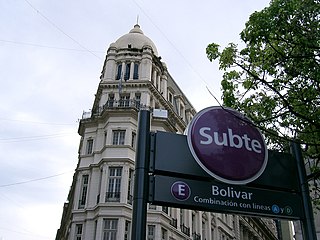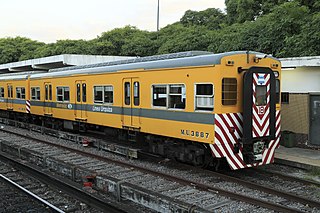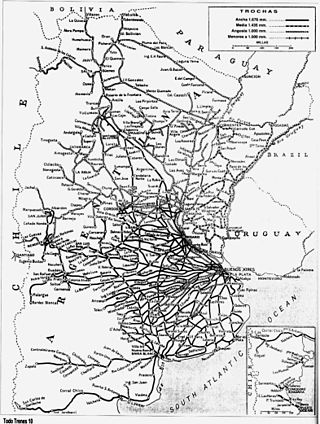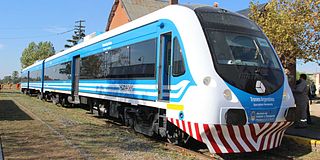
Transport in Argentina is mainly based on a complex network of routes, crossed by relatively inexpensive long-distance buses and by cargo trucks. The country also has a number of national and international airports. The importance of the long-distance train is minor today, though in the past it was widely used and is now regaining momentum after the re-nationalisation of the country's commuter and freight networks. Fluvial transport is mostly used for cargo.

The Buenos Aires Underground, locally known as Subte, is a rapid transit system that serves the area of the city of Buenos Aires, Argentina. The first section of this network opened in 1913, making it the 13th earliest subway network in the world and the first underground railway in Latin America, the Southern Hemisphere, and the Spanish-speaking world, with the Madrid Metro opening nearly six years later, in 1919. As of 2023, Buenos Aires is the only Argentine city with a metro system.

Line A is the oldest line of the Buenos Aires Underground. Opened to the public on 1 December 1913, it was the first underground line in South America, the Southern Hemisphere and the Spanish-speaking world. It made Buenos Aires the 13th city in the world to have an underground transport service. The line stretches 9.8 km (6.1 mi) from Plaza de Mayo and San Pedrito and runs under the full length of the Avenida de Mayo and part of the Avenida Rivadavia, and is used by 258,000 people per day.

Line C of the Buenos Aires Underground, that runs from Retiro to Constitución terminus, opened on 9 November 1934, and it has a length of 4.3 km (2.7 mi). It runs under Lima Sur, Bernardo de Irigoyen, Carlos Pellegrini, Esmeralda, la Plaza San Martín and Avenida Ramos Mejia streets. It not only connects to every other line on the system, but its termini at Retiro and Constitución also connect it to some of the most important commuter rail networks in Buenos Aires, such as the Mitre and Roca lines and also long-distance passenger services. It is thus an important artery in Buenos Aires' transport system. At the same time, it is also the shortest line in both terms of length and number of stations.

Line E of the Buenos Aires Underground runs from Retiro to Plaza de los Virreyes, a total distance of 12 km. Opened in 1944, the Line E was the last completely new line to be added to the Buenos Aires Underground, until 2007 when Line H was opened. The line has a history of being re-routed and extended due to having been historically the line with the lowest passenger numbers on the network.

Metrovías S.A. is an Argentine privately held company that operates the Metropolitan services of the Urquiza Line. 90% of Metrovías' shares are held by Grupo Roggio. Metrovías was also operator of the Buenos Aires Underground from 1995 to December 2021, when "Emova Movilidad S.A." took over the concession of the service for 12 years. Emova is also part of the Roggio Group and also associated with Metrovías.

The Tranvía del Este, also known as the Puerto Madero Tramway, was a 12-block "demonstration" light rail line in the Puerto Madero neighborhood of Buenos Aires, Argentina, in operation from 2007 to 2012. It used French-built Alstom Citadis 302 trams on loan, initially from Mulhouse, France, and later from Madrid, Spain, and was jointly operated by Alstom, Metrovías, and Ferrovías.

Although tram systems date to the late 19th and early 20th centuries, many old systems were closed during the mid-20th century because of the advent of automobile travel. This was especially the case in North America, but postwar reductions and shutdowns also occurred on British, French and other Western European urban rail networks. However, traditional tramway systems survived, and eventually even began to thrive from the late 20th century onward, some eventually operating as much as when they were first built over a century ago. Their numbers have been augmented by modern tramway or light rail systems in cities which had discarded this form of transport.

The Premetro is a 7.4-kilometer long (4.6 mi) light rail line that runs along the outskirts of Buenos Aires, connecting with the Buenos Aires Underground line E, at Plaza de los Virreyes station and then to General Savio, with a short branch to Centro Cívico. It opened in 1987 and is operated by Metrovías. Originally, the Premetro was to include many more lines, but shortly after the privatisation of the railways the projects were postponed and never materialised and only "Premetro E2" was built.

The Argentine railway network consisted of a 47,000 km (29,204 mi) network at the end of the Second World War and was, in its time, one of the most extensive and prosperous in the world. However, with the increase in highway construction, there followed a sharp decline in railway profitability, leading to the break-up in 1993 of Ferrocarriles Argentinos (FA), the state railroad corporation. During the period following privatisation, private and provincial railway companies were created and resurrected some of the major passenger routes that FA once operated.

La Brugeoise cars were Buenos Aires Underground (Subte) Line A rolling stock since its inauguration in 1913 till 2013 when replaced by new Chinese stock. They were built by the Belgian railway rolling stock manufacturer La Brugeoise et Nivelles between 1911 and 1919 for the Anglo-Argentine Tramways Company's first underground line. They were originally designed to run both as metro and tramway cars, but they were refurbished in 1927 for underground use only. They became the oldest underground rolling stock in commercial service in the world as well as a tourist attraction and part of Buenos Aires cultural heritage.

Servicio de Transportes Eléctricos de la Ciudad de México (STE) is a public transport agency responsible for the operation of all trolleybus and light rail services in Mexico City. As its name implies, its routes use only electrically powered vehicles. It was created on 31 December 1946 and is owned by the Mexico City government. STE is overseen by a broader local governmental authority, Secretaria de Movilidad de la Ciudad de México (SEMOVI)(Secretariat of Mobility of Mexico City), formerly (SETRAVI) which also regulates the city's other public transport authorities, including Sistema de Transporte Colectivo, Red de Transporte de Pasajeros del Distrito Federal and Metrobús, as well as other forms of transportation in the district. STE's passenger vehicle fleet consists exclusively of trolleybuses, light rail, and aerial lift vehicles, and in 2007 its network carried 88 million passengers, of which 67 million were on trolleybus services and 21 million on light rail.

Materfer is an Argentine manufacturer of railway and road vehicles, located in the city of Ferreyra in Córdoba Province. The company was established by Fiat Concord in the late 1950s, being its subsidiary until 1980 when Sevel Argentina took over Fiat vehicles.

The first trams in Buenos Aires began operating in 1863 in what quickly became a vast network of tramways with the city being known as the "City of Trams" for having the highest tramway-to-population ratio in the world. In the 1920s, Buenos Aires had 875 km (544 mi) of tramways and 99 tram lines using 3000 carriages running throughout the city. By 1963, the vast majority of the network began to be dismantled, though some minor tram services continue in the city today.

The Polvorín Workshop is a rolling stock storage and maintenance workshop in Buenos Aires that primarily serves Line A of the Buenos Aires Underground. It also serves as the main storage and restoration area for the Association of Friends of the Tramway (AAT), who run a heritage tramway in the neighborhood of Caballito, near to where the workshop is located.

The Regional Express Network was a planned commuter network system in Buenos Aires, which consisted in an underground connection among the 3 mainline railway stations of the city: Retiro, Constitucion and Once, in the north, south and west respectively.

The UEC Preston is a tram/subway car built by the British manufacturer United Electric Car Company for the Anglo-Argentine Tramways Company (AATC) in 1912 for use on its then newly built underground tramway in Buenos Aires, which was later to become Line A of the Buenos Aires Underground. Only 4 trams were built and they served on the line up until their retirement in 1977.
The Buenos Aires Underground has one of the most diverse metro fleets in the world, and has had some of the oldest models in operation on any network. The network began with a relatively standardised fleet, but throughout its over 100-year-long history, it has seen numerous purchases which have created cases where some lines operate numerous models. Recently there have been increased efforts to modernise and standardise the fleets, with large purchases from China CNR Corporation and Alstom.

The Anglo-Argentine Tramways Company, known simply as La Anglo in Argentina, was a large transportation company which operated the majority of the trams in the Buenos Aires network, which was also one of the largest in the world at the time having lines totalling 875 km (544 mi) in length. The company also created Buenos Aires' first underground tram line, which would go on to become Line A of the Buenos Aires Underground. The company also owned other tramways around the country.

The Ayacucho Tram is a Translohr tram system that serves the Metropolitan Area of the Aburrá Valley in Medellín, Antioquia, Colombia. It started trial operations on 20 October 2015. The tramline consists of 9 stations with three of those allowing interchanges with the Medellín Metro and the Metrocable systems. The Ayacucho Tram is operated by Medellín Metro and is the only tram in Colombia.






















